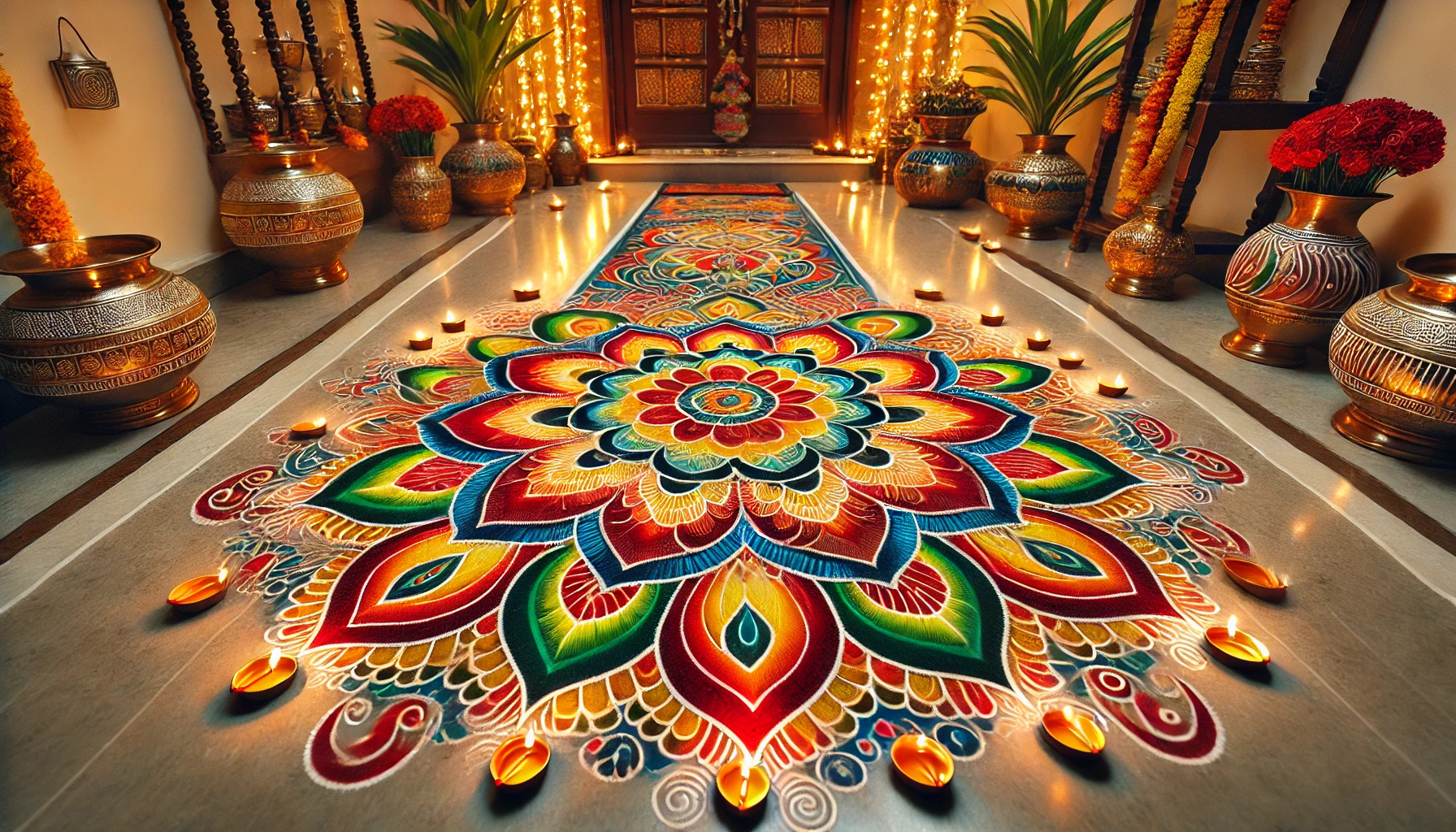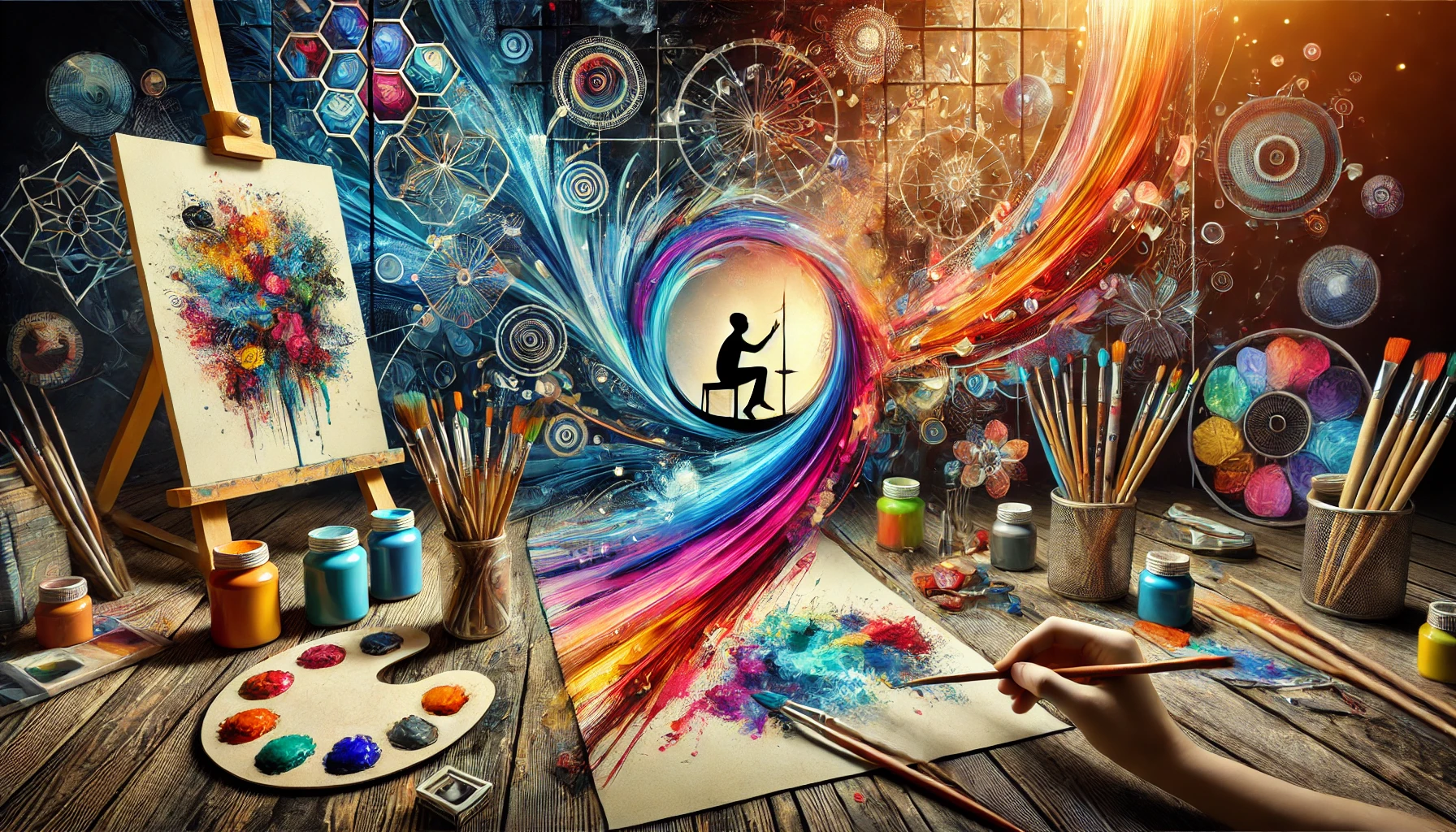Rangoli, the intricate and colorful art form rooted in Indian culture is a beautiful blend of creativity, symbolism, and tradition. Often created during festivals, weddings, and other auspicious occasions, rangoli holds a significant place in Indian households. Beyond its aesthetic appeal, it embodies the cultural values and spiritual essence of Indian traditions. This article delves into the history, techniques, designs, significance, and modern evolution of rangoli.
The Origins of Rangoli
Rangoli, derived from the Sanskrit words “Rang” (color) and “Aavali” (row), literally means a row of colors. The art form traces its origins to ancient India, with references found in texts like the Ramayana and the Mahabharata.
- Mythological Roots: According to legend, was first created to appease the gods, ensuring prosperity and happiness.
- Cultural Context: Historically, was used to welcome deities and guests, symbolizing hospitality and good fortune.
The Symbolism of Rangoli
is more than just decorative art; it is imbued with cultural and spiritual significance.
- Welcoming Prosperity: In Indian tradition, a at the entrance is believed to invite Lakshmi, the goddess of wealth, into the home.
- Dispelling Negativity: The designs are thought to ward off evil spirits and bring positivity.
- Community Bonding: -making often involves family members and neighbors, fostering unity and togetherness.
Traditional Materials and Tools
The materials used for vary across regions but generally include eco-friendly and natural elements.
- Traditional Powders: Colored powders made from rice flour, turmeric, and flowers.
- Additional Elements: Petals, leaves, grains, and diyas (oil lamps) are often incorporated for added texture and symbolism.
- Modern Additions: Acrylic paints, stencils, and synthetic powders have become popular for convenience and durability.
Techniques and Designs
-making is an art that requires precision, creativity, and patience. The process typically involves several steps:
- Preparation of the Surface: The ground or floor is cleaned, ensuring a smooth base for the design.
- Outlining the Pattern: Patterns are drawn using chalk or white powder, forming the structure of the design.
- Filling with Colors: The outlined spaces are filled with vibrant colors, petals, or other materials.
Common Rangoli Patterns
designs are inspired by nature, mythology, and cultural motifs. Some popular patterns include:
- Geometric Patterns: Symmetrical shapes like circles, squares, and hexagons.
- Floral Designs: Lotus, sunflowers, and other floral patterns are widely used.
- Deity Symbols: Representations of gods, their vehicles, or holy symbols like the Om or Swastika.
- Abstract Art: Contemporary artists often experiment with freeform designs and modern themes.
Rangoli Across Indian Regions
Each region in India has its unique style of , reflecting its cultural diversity.
- Kolam (Tamil Nadu): Made with rice flour, kolam features intricate geometric patterns.
- Alpana (West Bengal): Created using rice paste, alpana designs are artistic and elaborate.
- Sathiya (Gujarat): Features traditional motifs like swastikas and peacocks.
- Chowk Purana (Bihar): Uses natural colors to create vibrant, larger-than-life patterns.
Rangoli During Festivals
is an integral part of Indian festivals, enhancing the festive spirit and cultural ambiance.
- Diwali: is used to decorate homes, with diyas and candles enhancing the designs.
- Pongal: Kolam is made in Tamil Nadu to celebrate the harvest season.
- Durga Puja: Alpana designs adorn the entrances of homes and pandals.
- Onam: In Kerala, pookalam (floral) takes center stage during the celebrations.
The Spiritual Aspect of Rangoli
is deeply connected to spirituality. The symmetrical patterns symbolize balance and harmony in life. During rituals, serves as a sacred space to invoke divine blessings.
- Chakra Patterns: These represent the cosmic energy centers in Indian philosophy.
- Mandalas: Circular designs used for meditation and concentration.
The Evolution of Rangoli
While has its roots in tradition, it has evolved with time to include contemporary elements.
- Modern Materials: Synthetic powders, glitters, and acrylic colors are widely used for convenience.
- Themed Rangolis: Designers now create based on themes like national pride, social messages, or artistic expressions.
- Competitions and Workshops: competitions are popular in schools, colleges, and cultural events, encouraging the younger generation to embrace this art form.
Rangoli in Contemporary Art and Media
has transcended its traditional role and found a place in modern art and popular media.
- Art Installations: Large-scale rangoli installations are featured in exhibitions and public spaces.
- Digital Rangoli: Artists use digital tools to create designs, blending technology with tradition.
- Cinematic Presence: Rangoli often features in Indian films as a symbol of celebration and culture.
Sustainability in Rangoli
With growing environmental concerns, there is a shift towards eco-friendly -making practices.
- Biodegradable Colors: Natural dyes and organic powders are gaining popularity.
- Reuse and Recycling: Materials like flower petals and grains are repurposed after use, minimizing waste.
How to Create Rangoli: A Beginner’s Guide
For those new to, starting simple is key. Here’s a quick guide:
- Choose Your Design: Start with basic patterns like a flower or a star.
- Prepare the Surface: Clean the area and mark your design with chalk.
- Gather Materials: Use readily available materials like rice flour, turmeric, and petals.
- Begin Coloring: Fill the pattern carefully, maintaining symmetry.
- Add Details: Enhance your rangoli with diyas or glitter for a festive look.
FAQs About Rangoli
1. What is the purpose of rangoli?
is created to welcome prosperity, ward off negativity, and celebrate festivals.
2. Can anyone make rangoli?
Yes, is an inclusive art form that anyone can learn and practice.
3. Which materials are traditionally used in rangoli?
Rice flour, turmeric, flower petals, and natural dyes are commonly used.
4. What are the popular rangoli designs?
Geometric patterns, floral motifs, deity symbols, and abstract art are popular designs.
5. How is rangoli eco-friendly?
By using natural and biodegradable materials, can be made environmentally friendly.
Conclusion
Rangoli, with its vivid colors and intricate designs, is more than just an art form—it’s a celebration of India’s cultural diversity and spiritual ethos. From gracing the courtyards during festivals to becoming a medium of modern artistic expression, continues to enchant and inspire. Embracing this timeless tradition not only keeps a piece of India’s heritage alive but also fosters creativity, positivity, and togetherness in an ever-evolving world.











